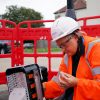Gov Ponders Approach to Gigabit Broadband in Remote UK Areas

The UK Government has just published a response to its consultation on the question of how significantly faster broadband ISP networks can be extended to reach the final 0.3% of the country (i.e. under 100,000 premises), which are too expensive for their new £5bn Project Gigabit programme to reach in its current form.
At the end of 2021 fixed line “superfast broadband” (30Mbps+) coverage had reached around 97% of UK premises and gigabit-capable (1000Mbps+) networks hit 65% (here). The latter is thanks largely to the combination of Virgin Media’s DOCSIS 3.1 upgrade to their existing hybrid fibre coax network and the wider commercial rollout of Fibre-to-the-Premises (FTTP) by multiple operators.
The Government’s new Project Gigabit programme aims to help further improve the picture for gigabit speed connectivity by using state aid to target connectivity improvements toward the final 20% of hardest to reach premises (i.e. helping to extend gigabit coverage to at least 85% of UK premises by the end of 2025 and then “nationwide” by 2030).
Advertisement
However, both Project Gigabit and the existing 10Mbps broadband USO scheme have long recognised that tackling those who live in so-called “Very Hard to Reach” areas would be “prohibitively expensive” (here and here). The current expectation is that, once the current programmes have completed, around 0.3% of premises (under 100,000 homes and businesses) could fall into this group.

Most of those described as being “Very Hard to Reach” exist across remote and isolated locations in Scotland and Wales, as well as some of England’s National Parks. Back in March 2021 the Government announced a new call for evidence to see if they could find any solutions for such areas, which might enable them to access significantly faster broadband speeds and in a more cost-effective way.
The government has now published a response to their initial consultation on this issue, which sadly doesn’t provide much of an indication on their future direction and largely just summarises the problems (e.g. high costs, access to spectrum, difficulty securing wayleaves and backhaul capacity etc.), as well as potential options with no big surprises. But they do intend to “set out a series of policy proposals” that will be forthcoming later in 2022, which will better explain how they intend to address the connectivity challenges.
Advertisement
Julia Lopez, Minister for Digital Infrastructure, said:
“I am proud of the work done so far by the telecoms industry, supported by the government and Ofcom, which has already delivered gigabit-capable broadband to over 62.5% of premises in the UK, including more than half a million homes and businesses in hard to reach areas. However, there is a lot more still to be done.
Our rural communities need good digital connectivity to prosper in an increasingly connected world, and we are committed to ensuring that no part of the UK is left behind. By definition, it is going to be much more difficult to deliver gigabit connectivity to the hardest to reach parts of the UK – around 20% of UK premises – and that is why we have committed a record £5 billion of capital funding to support deployment in these areas.
I am keen that decisions about better broadband are based on evidence from those who will be most affected by them. Detailed information about the demand for broadband services, their invaluable benefits, barriers to deployment and take-up is crucial. We also need evidence from suppliers and vendors on technology availability, maturity, capabilities and costs to provide connectivity in Very Hard to Reach areas, both in the UK and overseas.
I would like to thank everyone who submitted a response to this call for evidence. This will be used to inform the future policy decision making of the experiences of those facing limited connectivity so that we do not see a digital divide emerge.”
The expectation is that all of this could lead to the government encouraging the industry to use new fixed wireless solutions, LEO satellites (e.g. Starlink, OneWeb) and hybrid platforms to help push faster broadband into the hardest to reach areas. However, it is noted that LEO based solutions are still in early development and may yet run into capacity problems with wide take-up, at least in the medium-term.
We don’t yet know what the outcome of all this will be, but we could easily see a voucher approach being extended to help cover the cost of LEO hardware or to help subsidise wireless builds. But at present the £89 per month rental on Starlink is still far too expensive for most people, so that would ideally need to change first (or OneWeb may launch with better affordability on BT or Eutelsat’s service).
Finally, the Government noted that, during the evidence gathering process, a number of issues were raised that while not directly applicable to the terms of the call for evidence, do affect rural and remote premises. Therefore, the government has set out its response to these issues below, while wherever possible highlighting alternative government programmes that are available which can offer a more immediate solution. But as above, these responses don’t say anything particularly new.
Government Response
Why are you not addressing premises that are expensive to connect but are not geographically Very Hard to Reach?
As stated in the original call for evidence, some premises may not be geographically Very Hard to Reach but may present a potentially high cost to upgrade or service if there is a lack of economies of scale. This could be due to network deployment strategies or the availability of legacy services.
These premises may also appear when
- a new single premises is created in an area that has previously been upgraded meaning that the premises itself faces the entire cost of any works required, or
- a new development of premises is built with a new rollout or technology but a small number of nearby premises are not connected at the time (this may make them less economical in the future)
However, although the government recognises that these premises do exist a number of policies have already been put in place to help either infill existing rollout gaps or ensure that such premises are able to access improved connectivity when built.
To address issues with new build connectivity, we [have recently consulted /are currently consulting] on amendments to the Building Regulations 2010. Ensuring that new-build homes in England are built with gigabit-ready infrastructure and gigabit-capable connectivity. This legislation will build on the commitments that the government has already secured from network operators to work with housing developers to provide gigabit-capable connectivity to new build developments.
Building regulations are a devolved matter, so the legislative amendments to the Building Regulations 2010 will apply to England only. However, the provision of gigabit-capable connections to new homes is a priority for the government across the whole of the UK. We are therefore working with the devolved administrations to ensure this policy is implemented across the UK.
Many telecommunication companies are also already delivering connectivity to many of these premises, either through commercial deployments, as part of UK government-supported interventions or through a community broadband scheme.
As such we believe that these premises will be delivered through another route and do not face many of the other challenges that have been discussed throughout this call for evidence, therefore are unlikely to be Very Hard to Reach.
Why are urban premises not eligible for the government’s Gigabit Voucher Scheme?
The voucher scheme is designed to target government subsidies towards those living and working in the hard to reach, commercially unavailable, areas of the country. Urban areas are typically commercially viable and often have 4G and sometimes 5G availability.
The Gigabit Broadband Voucher scheme ensures that those communities and businesses in rural areas not in line for commercial rollout and those that do not want to wait for Project Gigabit procurements, can get more immediate help with the costs of installing a gigabit-capable connection.
The government has recognised that not all areas of the country, particularly those in the most rural and remote areas, are likely to benefit from network competition and receive gigabit-capable broadband through private investment alone, which is why we are investing £5 billion to support deployment in these areas. The use of this funding will encourage a variety of rural broadband providers to deploy gigabit networks.
When will the government address the USO speed threshold so it is more applicable to modern broadband needs?
The broadband Universal Service Obligation was introduced in March 2020, following a consultation in 2016, in addition to further analysis that was carried out by Ofcom to inform the design of the broadband USO.
Following consideration of Ofcom’s technical advice to the government, it was determined that the minimum download speed of a connection provided under the USO should be 10 Mbps, with additional quality criteria added to ensure that the connection gave users a good experience.
10 Mbps was believed to balance a household’s typical needs with a proportionate approach that took into account the costs to industry and the potential impacts on a competitive market. The specification allows for access to common web-based services including emails, web browsing and HD video streaming across multiple users.
BT has already built USO connections that cover over 3,700 homes and are in the process of building over 2,500 more. The overwhelming majority of these connections have been delivered using Fibre to the Premises and therefore deliver speeds well above 10 Mbps. KCOM has already substantially upgraded its network to full-fibre broadband and has consequently not needed to make connections under the USO in Kingston-upon-Hull, where it operates.
However, the government recognises that the broadband Universal Service Obligation may need to be updated in the future. As a result, it ensured there was a review mechanism within the Communications Act 2003 once 75% of premises in the United Kingdom take up a Superfast broadband service of at least 30 Mbps. Ofcom reported in Connected Nations 2021 that the take up of Superfast broadband was 69%.
Will the government increase the cost threshold for the broadband Universal Service Obligation?
The broadband Universal Service Obligation remains an important tool in getting gigabit-capable broadband to the hardest to reach communities. We received responses to the call for evidence from several respondents calling for the broadband USO cost threshold to be raised.
However, when setting both the cost threshold for the broadband USO, the government has to ensure that costs for both industry and consumers are proportionate. When consulting on the broadband USO the government was clear that not all premises would fall below the reasonable cost threshold. Indeed such premises are likely to cost far more than the cost threshold and therefore potentially be categorised as Very Hard to Reach.
In addition, the Government expects that recent amendments to the way that the Universal Service Providers calculate excess costs will mean that more consumers can benefit and have a clearer idea of the costs associated with their specific premises.
Will the Gigabit Broadband Voucher Scheme’s voucher limits be raised to make it easier for Very Hard to Reach premises to access an improved broadband connection?
The government’s Gigabit Broadband Voucher Scheme remains an important tool in getting gigabit-capable broadband to communities – especially as the wider Project Gigabit rollout begins.
We received responses to the call for evidence from several respondents across market participants and representative organisations that noted more premises could be served if the voucher limits were increased.
Currently, premises in 12 English Council areas, as well as Scotland and Wales, can access ‘top-up’ funding totalling nearly £26m. Each local authority or devolved administration is responsible for providing the ‘top-up’ funding at a level that they deem appropriate for their area. This is in addition to the initial £210m available through the voucher scheme already.
At the current values, the ability for households and businesses to club together to increase the total subsidy of a project has typically enabled communities to cover most or all of the costs for installation, after supplier contributions. However, all products including vouchers are reviewed every 6 months. At this juncture, BDUK evaluates performance, identifies potential opportunities for improvement, and makes adjustments where necessary with DCMS approval.
Will the government increase spectrum availability in order to address challenges for Fixed Wireless Access and satellite providers?
Ofcom is the independent regulator responsible for managing spectrum in the UK. DCMS continues to work with Ofcom and other stakeholders to ensure spectrum access is supporting our connectivity ambitions..
On satellite applications, a number of frequency bands are available for such services. Ofcom has recently issued a consultation seeking to update its Non Geostationary Satellites (NGSO) licencing framework, to best enable multiple NGSO satellite operators to provide services in the UK; within the constraints of minimising interference between the systems and within the International Telecommunications Union framework as well as to explore the limitations for this.
A variety of spectrum bands are also available for FWA technologies. In 2019, Ofcom introduced a new framework for shared, localised access to spectrum to support innovation. This framework, which provides local access to spectrum in a number of bands including the 3.8-4.2GHz, as well as local access to unused nationally licensed mobile spectrum, is applicable for FWA applications.
Will the government change their procurement schemes so that satellite providers are able to bid to connect premises that would otherwise not be connected by a gigabit-capable provider?
The government’s approach to the BDUK Project Gigabit procurements as well the Gigabit Broadband Voucher Scheme is technology agnostic. Therefore satellite providers are more than welcome to bid for funding.
However, at present satellite broadband is unable to meet the technical specifications for funding under either BDUK Project Gigabit procurements or the Gigabit Broadband Voucher Scheme and therefore is not currently able to bid for BDUK funding under these schemes.
As the government looks at potential solutions to address Very Hard to Reach Premises we will continue to evaluate evolving alternative connectivity solutions noted in the call for evidence including satellite, Fixed Wireless Access and High Altitude Platform systems. This includes the evaluation of their offered performance, capacity and readiness for service.
Mark is a professional technology writer, IT consultant and computer engineer from Dorset (England), he also founded ISPreview in 1999 and enjoys analysing the latest telecoms and broadband developments. Find me on X (Twitter), Mastodon, Facebook, BlueSky, Threads.net and Linkedin.
« Gov Names Winners of New Pilots to Aid 5G via Street Furniture UPDATE























































The taxpayer shouldn’t have to foot the bill if someone chooses to live like a hermit on remoteland
It’s not much of a choice if you’re born there.
In china, the state id forbids one individual from working or buying a house in a different region. The UK is not china, free mobility exists. Most jobs exist where other people exist too.
Remote locations are better served by Mr Elon Musk
It takes time for people to reach the stage in adult life where they have enough money to fuel an “escape” into more prosperous, but often also more expensive, urban areas (assuming they reach that stage at all). Some cities are also so expensive, such as London, that this often simply isn’t realistic.
Meanwhile, various studies indicate that the economic benefits of better broadband tend to result in fairly good value for the public purse (it usually pays for itself). By improving broadband you also support more growth and provide new locations for businesses to setup. Even big cities once started out as little more than villages.
Please don’t strawman my argument. Yes, London is expensive and far too many lunatics believe they should afford living a comfortable life in it on minimum wage
However according to your own article, it is only “the most remote 0.3% of premises in the UK” that are too costly to deliver. I’m not calling on someone living in the most remote UK location to move to London, simply that spending 20000+ to connect one home using taxpayer money is more expensive than starlink or even just paying someone to rent in the nearest small town
You got no choice! That’s up to government decision.
Then the tax payer shouldn’t foot the bill at all for broadband connectivity. This Isn’t medical care or welfare. People in the main don’t ‘need’ to be able to work from home and therefore don’t ‘need’ state funded high speed broadband, Drive to the office and work from there and if that’s too far move and buy a house in town.
Odd to think 20k is too much to spend for a virtually permanent low maintenance/running cost service and direct people to a leo sat solution with 250k a pop 5 year lifespan space junk high user running costs and a limited bandwidth/speed.
Remember those living in a more remote area, pays tax, which was used to provide subsidy for better speeds for more urban areas that probably already had better connectivity than theirs.
Remember about half of working age households don’t pay enough tax to cover their own cost to the state.
Anonymous that statement is likely factually true but the reasons for it are so complex it matters not once broken down. We don’t have voting in factions relating to how much tax you generate, in my view its none starter sentence with no merit to this conversation.
My personal view is that the country as a whole should be blanketed with Fibre that anywhere in the UK can connected too. Its a fairly longer life term technology that has massive growth possibilities for 100+ years of use, it is the new copper and we made near damn well possible to make calls over copper lines from just about anywhere.
Having that underlying infrastructure like roads promotes growth and flexibility for data. More and more now traditional broadcasting is being moved to data services and I have read stats else where showing that data services bring in as much economic activity as the roads network now nationwide.
Honestly its a no brainer in my view
I’m with Brian and Pete on this, we either do it or we don’t.
Accept the fact that rural and more isolated areas are going to cost more the same as providing all services do to these areas per head of population.
I deeply resent the fact the Scottish government feel that it is fine to deploy dozens of subsea fibre links to remote islands but consider the houses on our road a few km between 2 fttc enabled areas as not worth connecting.
I’ve had great success with Miktrotik 60GHz wifi links, am using one to send this comment, to connect to my FTTP service into a different location. They’ve been used successfully by rural internet ISPs.
They call it a wireless wire, and I really do get gigabit speeds across the link with maybe 1ms delay each way, not enough to notice.
The units are quite small, very roughly the size of three DVDs stacked.